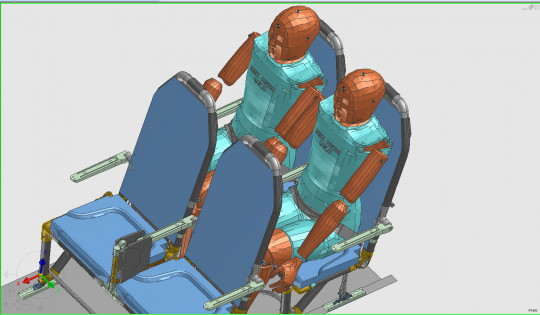
“Zero Prototype”: Expliseat Relies on ESI’s Simulation Software to Develop Ultra-Lightweight Aircraft Seats Using Carbon Fiber Composites
ESI is a partner of choice for Expliseat. Our first model, TiSeatE1, has been the first-ever aircraft seat to be developed fully digitally. We managed to develop a seat with “Zero Prototype”, in the sense that we fully relied on simulation to make the right choices at the right time, from product design until Virtual Pre-Certification.
Benjamin SaadaPresident, Expliseat
The French start-up Expliseat is only 10 years young. Yet, it already shows a track record for success like no other. As the aerospace industry is facing sustainability challenges, Expliseat’s ultra-light seats enable airlines to reduce both fuel costs and CO2 emissions. Expliseat’s seats weigh around 6kg each (an average of 4kg less than traditional seats), use 50% fewer parts, and this, without compromising passenger safety or comfort. So how did Expliseat manage such a technical achievement? And what product development methodology do they use to make sure they hit their next target?
Digitalization is their greatest asset
In the true sense of start-ups, digital runs deep in their blood. Expliseat is a small company with only 30 people working in product development, yet the company recorded stellar growth thanks to the attention and budgets allocated to digital investments. From Computer-Aided Design (CAD) to Finite- Element (FEA) simulation but also Human Resources (HR), Customer Relationship Management (CRM), Enterprise Resource Planning (ERP), Product Data Management (PDM), Expliseat trusts digital solutions to bring important benefits including simplicity (therefore happiness), speed, product and process quality, not to mention a sense of community.
Partnering with ESI for simulation
Benjamin Saada, President of Expliseat, comments “ESI is a partner of choice for Expliseat. Our first model, TiSeatE1, has been the first-ever aircraft seat to be developed fully digitally. We managed to develop a seat with “Zero Prototype”, in the sense that we fully relied on simulation to make the right choices at the right time, from product design until Virtual Pre-Certification. We did not produce any physical prototype until the final one required for certification by the European Union Aviation Safety Agency (EASA), which confirmed that our product successfully complied with all safety requirements. ESI was one of the main partners involved in this success. We immediately understood that ESI’s simulation solutions are a strategic asset for product development in the aerospace sector.”
Expliseat keeps rising competencies in simulation
In 10 years, 13 of their aircraft seat models have been certified to fly on most aircraft types used for short and medium-haul flights. In the past 3 years, they improved computational calculation speed by 300%.
Optimizing Cloud usage
When the company started, they had 10 workstations. Expliseat now uses Google Cloud services, which allows them to use up to 2000 cores to run state-of-the-art simulations, without requiring heavy hardware investments. The company keeps optimizing its High-Performance Computing (HPC) capabilities in the Cloud: not only do their computations run much faster, but Expliseat also optimizes resources and costs to control the development costs of their programs.
Platform development
Widespread in the automotive industry, cross-platform development is based on using the same parts for multiple product variations. By working on similar underpinnings, yet offering distinct designs or functionalities, manufacturers successfully answer the need for customization, whilst keeping development costs to a minimum. “Platform development is still emerging in the aerospace industry. When we saw what ESI’s automotive customers could do with simulation, we understood that replicating proven simulation processes would be a strategic asset for Expliseat.”
The TiSeatE2 program embodies the success of cross-platform development at Expliseat. The model has now been deployed on 4 different aircraft types. 80% of the parts are common to all 4 variations. “We hope to raise this even more in the coming years, as we know it’s possible to achieve up to 90% similarity in the automotive industry”, says Saada.
Safety first
Aircraft seats are the primary passenger safety equipment onboard. When Expliseat thought of using carbon fiber composites to reduce the weight of its seats, they knew dynamic tests were going to be extremely challenging. Benjamin Saada comments “In combination with Expliseat’s worldwide expertise in composites, ESI’s simulation has been a strategic tool in our technology portfolio to achieve the desired safety requirements.”

TiSeat E2 seat model on Porter Airlines Dash 8-400 aircraft. Image courtesy of Expliseat.

Manufacturing 4.0
“We are convinced that we can achieve further weight reduction thanks to new manufacturing processes, but this will require redesigning or reoptimizing a certain number of product parts. Therefore, using ESI’s solutions for Manufacturing 4.0 is our next move. We hope to achieve greater mass optimization and to decrease lead times while minimizing product development risks and avoiding conservative design decisions. Relying on simulation will help us in further reducing seat weight by precisely raising parts robustness where needed while decreasing it where we have greater margins,” explains Saada. ESI’s manufacturing process simulation solutions will also help Expliseat with the start of production of new models, because “No one wants to find out that a tooling can’t do the job when it’s meant to happen,” he smiles.
About Expliseat
Expliseat is the manufacturer of the lightest aircraft seat in the world: the TiSeat. It combines high-performance materials with innovative solutions to improve transport efficiency. Seats made by Expliseat are certified according to the latest aviation airworthiness requirements that include Head Injury Criteria (HIC) tests. TiSeats are available on multiple aircraft platforms including Airbus A320, Boeing 737, ATR, De Havilland Dash 8 or Dassault Falcon Jets. In 2020, TiSeat is flying with 15+ airlines worldwide with great feedback and recognized benefits on both revenues and the environment. Massive weight saving on the aircraft is allowing, among others, to reduce fuel consumption with a significant impact on CO2 emissions reduction.
Fore more info, please visit https://expliseat.com/